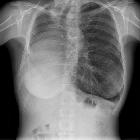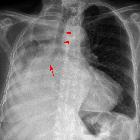Post-pneumonectomy syndrome








Post-pneumonectomy syndrome is delayed complication of pneumonectomy characterized by respiratory compromise caused by severe mediastinal shift and counterclockwise rotation of the heart and great vessels.
Epidemiology
Rare delayed complication of pneumonectomy, which more commonly involves the left main stem bronchus after a right pneumonectomy. Very rarely it involves the right main stem bronchus post left pneumonectomy in the presence of a right aortic arch.
It primarily involves children and young adults and women within a year after surgery, probably related to increased elasticity and compliance of their lungs and mediastinum in these groups, compared with older patients and men.
Clinical presentation
Symptoms include exertional dyspnea, inspiratory stridor, and recurrent cases of pneumonia.
Radiographic features
Plain radiograph
May show a completely opacified involved hemithorax with ipsilateral mediastinal shift. Surgical clips may be identified at the lung hilum or resected lung.
CT
This is the modality of choice for diagnosis. It better demonstrates the plain radiographic findings and may additionally show abnormal stretching and narrowing of the distal part of the trachea and the left main bronchus that is entrapped between the pulmonary artery anteriorly and the aorta and spine posteriorly. May also show the heart descending in the involved hemithorax and rotated counterclockwise along its main axis.
Treatment and prognosis
Several surgical options described; the main aim is to reposition the mediastinal structures to the midline. One of the options is Silicone breast implants have been used in the involved pleural space to prevent ipsilateral rotational shifting of mediastinum.
Siehe auch:

 Assoziationen und Differentialdiagnosen zu Post-Pneumonektomie-Syndrom:
Assoziationen und Differentialdiagnosen zu Post-Pneumonektomie-Syndrom:

